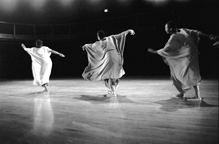

Adenike Sharpley took on a challenge last weekend. The artistic director of Dance Diaspora introduced the troupe's performances telling the audience they couldn't simply sit back and sit quietly during the dances.
"You can't just lean over to your neighbor and whisper 'I liked that,'" she told the audience. "You have to make noise."

And even though it's not easy to get Obies excited about much of anything, Sharpley's orders weren't hard to follow. Even the most reticent observer would have been hard-pressed to sit still through the performance.
While traditional performances might be seen as simply that-a carefully choreographed and polished show-Dance Diaspora could more accurately be called an interaction. Its strength came from the engagement between the dancers themselves, the dancers and their music, as well as the dancers and the audience.
Another strength came from Dance Diaspora's integration of a cohesive dance style with individual talents and characters. The troupe is definitely a combination of many parts. It was exciting to see so many different kinds of bodies and movements together on one stage.
Many of the dances included opportunities for individual dancers to take center stage. These highlights allowed the audience to develop relationships with individual performers as well as the troupe as a whole.
In addition to the relationship between the dancers and the audience, the chemistry between the dancers and their drummers, Ilu Aiye, was engrossing. Feeding from one another's energy, the drummers' and dancers' communication throughout the evening was captivating and dynamic.
Between the dance sets Ilu Aiye performed drum pieces, many inspired by Caribbean music. Although the pieces were strong and well-performed they sometimes broke up the energy of the dances.
Two particularly strong dances were the circumcision/Sousou Ballet and the Cassa. The ballet is traditionally danced after a female circumcision. According to the program notes the dance was done to prove the woman was strong enough to enter adulthood.

The energy of the dance grew throughout, culminating when the dancers circled one dancer then exited the performance space one at a time, eventually leaving the single dancer alone who, jolting from a practical stand-still, exited with incredible energy. The use of contrast, between the stillness and movement, was highly effective.
The Cassa, the last dance of the night, was playful and sexy. Encouraged by the audience, Ilu Aiye, and the dancers themselves, individual dancers took center-stage, pushing their own creativity and energy.
Seven dances made up the troupe's weekend performances, many of which were inspired by a trip to Gambia, West Africa that five of the Diaspora dancers took last summer. Studying under Mamadou Jarju, who is part of the Yarambamba Cultural Troupe in Western Gambia as well as Alassam Souma of the Fatala Dance Troupe of the Guinea the dancers learned techniques and choreography used now in Africa.
Sharpley, who is lecturer-in-residence at Afrikan Heritage House, founded Dance Diaspora six years ago.
Solo: One member of the Dance Diaspora company takes center stage. Individual dancers to metthe audience and established a rapport, crucial to the eveningšs success. (photo by Stephen Menyhart)
Diaspora: Three dancers take the stage, and the audience got to their feet, both overcome by the infectious music, at Saturday's Dance Diaspora concert. (photo by Stephen Menyhart)
Copyright © 1998, The Oberlin Review.
Volume 127, Number 12, December 11, 1998
Contact us with your comments and suggestions.